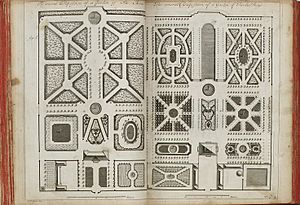Dezallier d'Argenville facts for kids
The Dezallier d'Argenville family was famous in the 1700s for having two talented writers and experts: a father and his son. They both wrote important books and were known for their knowledge.
The father, Antoine-Joseph Dezallier d'Argenville (1680–1765), is best known for his detailed book on French gardens. He also wrote about nature and collected many old art prints.
His son, Antoine-Nicolas Dezallier d'Argenville (1723–1796), wrote popular guidebooks about Paris. He also wrote about nature and famous architects and sculptors.
Contents
Antoine-Joseph Dezallier d'Argenville: The Gardening Expert
Antoine-Joseph Dezallier d'Argenville was born in Paris on July 1, 1680, and passed away on November 29, 1765. He was a lawyer and also worked for the king. He loved gardening and even designed two gardens for his own family.
His experiences led him to write a very important book called La théorie et la pratique du jardinage (The Theory and Practice of Gardening). It was first published in 1709. This book was different because it was written by someone who wasn't a professional gardener. It was more like an architecture book, for garden designers and owners.
What Was in His Gardening Book?
Dezallier d'Argenville's book had two main parts. The first part talked about the rules for designing beautiful gardens. This included where to place a country house in relation to its gardens. It also covered how to create geometric shapes in flowerbeds (called parterres). He explained how to plan tree-lined paths and formal tree areas (bosquets). The book also discussed where to put garden buildings and statues, which were very important in French gardens.
The second part of the book focused on practical steps. It explained how to build terraces and stairs. It also covered the water systems needed for fountains, waterfalls, pools, and canals.
Why Was His Book So Popular?
His ideas made it possible for more people, even those who weren't super rich, to have beautiful formal gardens. This made his book incredibly popular. It became the most important guide for French formal gardens in the 1700s, following the style of the famous gardener André Le Nôtre.
The book was reprinted 13 times in France. It was also translated into German and English. The English version even helped introduce the "ha-ha" to many English gardens. A "ha-ha" is a hidden ditch that acts like a fence but doesn't block the view.
His Work on the Encyclopédie
Dezallier d'Argenville also helped create the famous Encyclopédie. This was a huge collection of knowledge put together by Denis Diderot and Jean le Rond d'Alembert. He wrote or edited more than 600 entries for it, starting in 1751.
His Interest in Nature
He was very interested in natural history. He wrote two books about it: one on shells and another on minerals. Collecting beautiful shells was a popular hobby for gentlemen back then. These collections were often kept in special "cabinets of curiosities" before science developed new ways to classify nature.
In March 1750, he was even chosen to be a member of the Royal Society of London, a very respected scientific group.
His Art Collection
Besides gardening and nature, Dezallier d'Argenville was a big collector of art prints. He organized his large collection by subject, not by the artist's style. He wrote about how to choose and arrange an art collection in an article in 1727.
His collection included many prints showing clothing and fashion from different countries. After he passed away in 1765, his property was sold. Records show his collection had 1,600 costume prints. Today, four volumes from his collection are kept at the Bibliothèque de l'Arsenal in Paris.
Antoine-Nicolas Dezallier d'Argenville: The Guidebook Writer
Antoine-Nicolas Dezallier d'Argenville (1723–1796) was Antoine-Joseph's son. He became a successful writer too.
Travel Guides to Paris
He wrote a popular guidebook called Voyage Pictoresque de Paris (Picturesque Journey of Paris). It came out in 1749 and helped people discover the best art, sculptures, and buildings in Paris. It also described the city's important academic and scientific groups. This guide was so popular that it was reprinted at least six more times before the French Revolution.
He also wrote a guide to the areas around Paris, called Voyage pittoresque des environs de Paris. This book, published in 1755, described royal houses, castles, and other fun places within about 15 leagues (around 45 miles) of the city. He especially praised the beautiful gardens in these areas.
Other Books
Antoine-Nicolas also wrote books about natural history, including Dénombrement de tous les fossiles de France (Inventory of all French Fossils).
He put together a two-volume book called Vies des Fameux Architectes Depuis la renaissance des Arts (Lives of Famous Architects Since the Renaissance of Arts). The second volume was about sculptors. He also wrote a dictionary about gardening and a gardener's manual.
See also
In Spanish: Antoine Joseph Dezallier d'Argenville para niños



